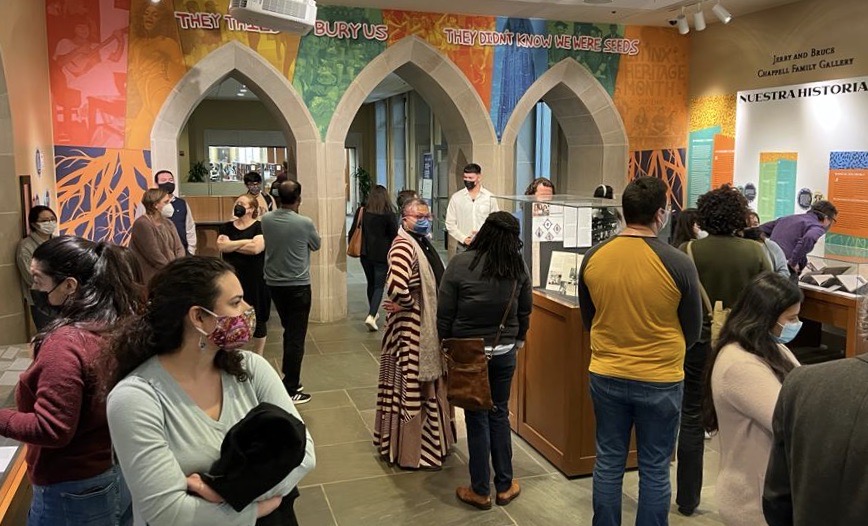
The following excerpt is from Dr. Cecilia Marquez, Hunt Family Assistant Professor of History. Dr. Marquez was one of the speakers at an event celebrating the exhibition, Our History, Our Voice/Nuestra Historia, Nuestra Voz. The exhibition was on display in the Chappell Family Gallery from January through July 2022.
I came to Duke as an Assistant Professor in the History Department in August 2019. Nine months later, just after I had found a doctor, a grocery store, and a routine, the world shut down as a result of the COVID-19 pandemic. Along with my students, I was reaching for some kind normalcy and some kind of optimism in what was an increasingly bleak world of quarantines, Zoom calls, and isolation. The exhibition Our History, Our Voice/Nuestra Historia, Nuestra Voz can’t be understood outside of this context. As much as the exhibition was a call for recognition, it also became a way to build community when we were scattered across several states.
It feels almost clichéd to say I learned as much from my students as I taught them, and yet it’s true. The students I have encountered at Duke, and those who curated this project, are some of the most resilient and dedicated young people I have ever known. I watched these undergrads withstand an unprecedented and generational trauma because of COVID-19. Through that they produced something truly beautiful and supported each other in the process. Their vision and dedication to this project was the fuel that made it all possible.
“In high school, as an AP US history student, my burning question was constantly: where are Latinos in US history? Where were we in the Civil War? Where were we in World War II, and in other big moments in US history? That was my constant burning question.” — Elizabeth Barahona
The exhibition is a testament to all parts of Duke really working together: faculty, staff, and students. Too often the emphasis at Duke is on faculty and students but this exhibition would not have been possible without library staff who led the way as we learned what it meant to create an exhibition.

During this project, Assistant University Archivist Amy McDonald taught dozens of my students how to discover and engage with archival material. Meg Brown, head of Exhibition Services, taught them how to make an exhibit, construct a project, and reimagine it again and again. Teaching Latinx history these past two years was a collaborative endeavor with Amy, Meg, and my co-conspirator in this project, Senior Lecturer in Romance Studies, Joan Munné, as we imagined this exhibition and brought it to fruition. At every step, I was reminded that the work we do at Duke is a collective and community effort that is not possible without the library and its staff.
“[This exhibit] It’s history in the making. You are witnessing history right now. It’s time to hear about those other stories. Those brown stories that have been here, but are not told because no one is asking us or writing about us.” — Elmer Orellana
It is my hope that this exhibition is the beginning of telling the history of Latinxs at Duke, not the end. There are many voices that were not represented in the exhibition, maybe some reading this now. The exhibit opened during Black History Month, making us acutely aware that Black Latinx students could not attend Duke until March 1961, when Duke first accepted Black students. Generations of Latinx students were systematically excluded as a result of Duke’s racist admissions policies. Early research from Dr. Javier Wallace, a Postdoctoral Fellow at Duke, suggests that during this time Black Latinx students found a home at North Carolina Central University (NCCU). The absence of their stories in the early period of the exhibition is notable and an urgently needed future direction of this project. In the process of constructing this exhibition and future projects like this one, we also construct a fuller and more representative archive of what the Latinx community looks like at Duke.

Nuestra Historia was sponsored by the Duke University Libraries and the following Duke entities: Latino/a Studies in the Global South Program, History Department, Romance Studies Department, the Provosts’ office, Dean Valerie Ashby, the Dean of Humanities, the Forum for Scholars and Publics, and the Franklin Humanities Institute who funded a Story+ Program to continue the work of this exhibit in the digital sphere.


